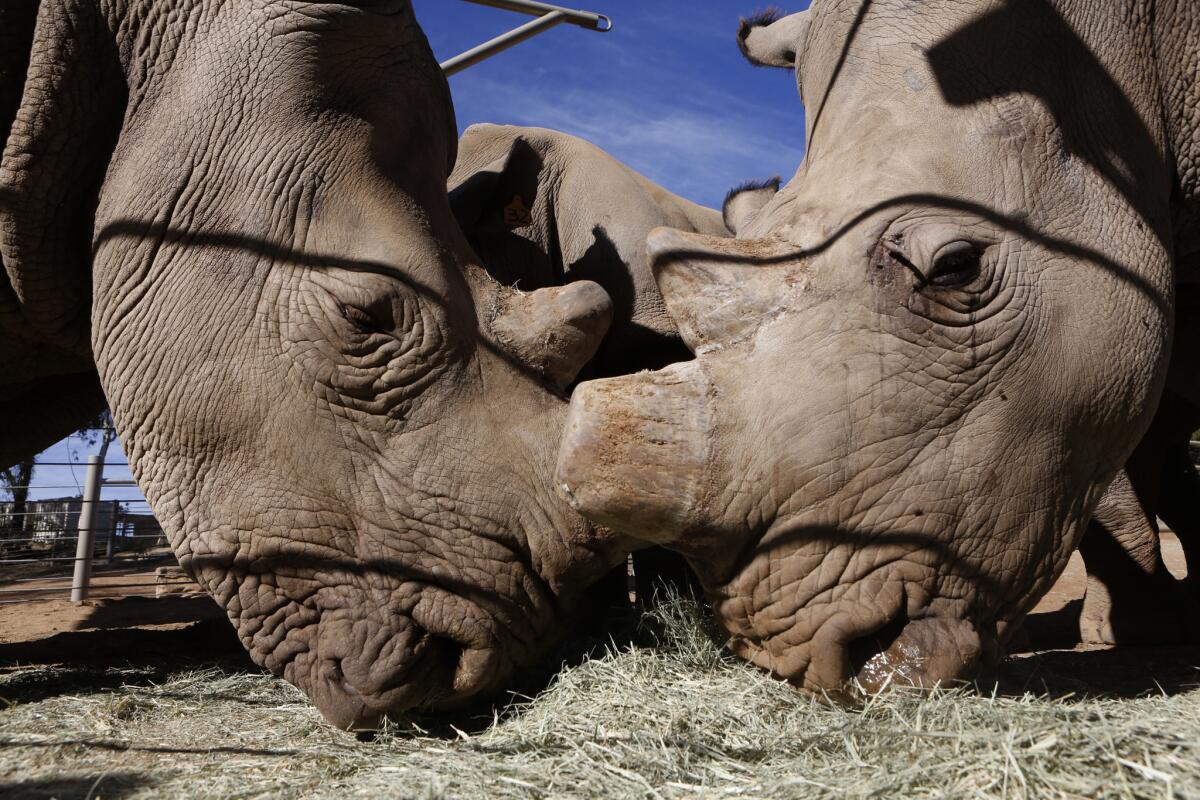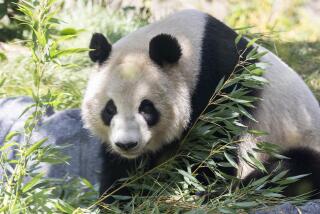Officials hope 6 new rhinos at San Diego Zoo Safari Park become scientific superstars

Six female southern white rhinos recently arrived at the San Diego Zoo Safari Park to be part of a conservation program aimed to help rhinos avoid extinction.
- Share via
Hopes are high at the San Diego Zoo Safari Park that the six newly arrived southern white rhinos, as yet unnamed, may someday earn the same elevated status as the panda Hua Mei and the condor Sisquoc.
Hua Mei and Sisquoc are celebrated figures in the race to prevent the extinction of species that once roamed the Earth but have been ravaged by modernity.
Hua Mei was born at the zoo in 1999; Sisquoc was hatched there in 1983. Each has gone on to help repopulate their species.
Now, much of the attention of zookeepers and conservation specialists has turned to the plight of the rhino.
The northern white rhino is down to four animals: Nola, an aging female, at the Safari Park, and two females and a male at a sanctuary in Kenya.
Other categories of rhinos are not quite as imperiled, but the long-term outlook is not promising because of poaching, habitat destruction and warfare in their native lands.
By some estimates, rhinos could disappear from the wild within a generation. Three of five categories of rhinos are on an international “red list” as critically endangered.
The six southern white rhinos arrived in individual crates on Nov. 5 after a charter flight from South Africa and then a California Highway Patrol escort from Lindbergh Field.
They are all females, brought from private preserves in South Africa, ages 4 to 7 and not yet full-size.
The oldest, acting as the grande dame in the rhino pecking order, weighs about 3,000 pounds and may top out at 3,500 pounds or so. The others are in the 2,000- to 3,000-pound range.
The immediate goal is to see whether one or more of the rhinos could act as a surrogate to give birth to a northern white rhino, or more likely a hybrid northern-southern white rhino.
Reproductive research is underway at the zoo’s Institute for Conservation Research and the Center for Regenerative Medicine at Scripps Research Institute in La Jolla.
The road is long, and success is uncertain. Much is unknown about the reproductive system of the rhino.
And then there are practical concerns: The rhino’s uterus is deep within its body. Special instruments will have to be developed to reach the uterus.
“If everything we have to do works, we think we could have a northern white rhino baby by 2023,” said Barbara Durrant, director of reproductive physiology at the conservation institute, which has facilities at the Safari Park and the zoo.
Semen from Angalifu, the northern white rhino who died a year ago at the Safari Park, is on file at the institute’s Frozen Zoo, which keeps thousands of egg, sperm and tissue samples from several hundred species of animals.
At the Ol Pejeta Conservancy in central Kenya, a project is underway to extract semen from Sudan, the world’s last living male northern white rhino. Sudan is under armed guard to thwart poaching.
No technique has been developed to extract eggs from a living female northern white rhino. Only after death can the eggs be harvested.
At 41, Nola is geriatric. She has been treated for a variety of age-related ailments, including a persistent abscess. She has good days and then bad days when she seems listless.
When she dies — which zookeepers hope is many years away — veterinarians and conservation specialists will have only a matter of minutes, maybe an hour, to extract her eggs.
Even then, because of her age, the eggs may not be viable. Angalifu’s semen has already been examined and found to be not particularly robust. He was 44 when he died of cancer.
At Scripps, work is underway on a northern white rhino stem-cell line. Stem cells are cells from which other kinds of cells form.
Although it has never been accomplished in an animal as complicated as a rhino, the theory is that eggs and semen could be produced from a stem-cell line that could, in the laboratory, create a northern white rhino embryo for which a southern white rhino would act as a surrogate.
But that may be years away. If a pregnancy occurs, the normal gestation period in rhinos is 16 months.
The six arrivals from South Africa are not on exhibit. Their federally mandated quarantine is finished but construction on an update to the rhino area at the park’s East African exhibit will not be completed until mid-December.
By examining their feces — rhinos leave large, greenish, smelly deposits — Durrant and Steve Metzler, the animal-care manager who accompanied the rhinos on the flight from South Africa, are determining the overall health of the six and whether any has ever given birth.
Metzler pats the animals on the rump, getting them comfortable with human contact in advance of the day when instruments may be inserted.
At the zoo, the poster animal is the panda. At the Safari Park, the rhino plays the same role.
Even before the arrival of the six, the park had three male southern white rhinos and eight females.
Dozens of southern white rhinos born at the Safari Park have been sent to zoos and sanctuaries around the world. No northern white rhino has been born here.
Durrant is convinced that what will be learned from working with the six females will aid conservation efforts with other categories of rhinos: the Javan, the Sumatran, the Indian.
“We’re going to get so much information from these six healthy females of reproductive age,” said Durrant, before hurrying off to gather “a real good feces sample.”
African names for the newly arrived rhinos will be selected by consulting with the park’s donors and a social media outreach to the public.
As they wander in their enclosure, the six are unaware that conservation celebrity could await them.
“We’ve tried to tell them, but we’re not sure they’re listening,” Metzler said.
ALSO
Red panda on the loose in California
Why the animal world is obsessed with staying clean
NIH says it will retire all remaining research chimpanzees
More to Read
Sign up for Essential California
The most important California stories and recommendations in your inbox every morning.
You may occasionally receive promotional content from the Los Angeles Times.










